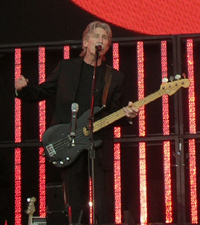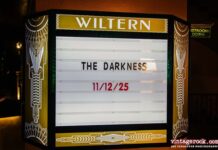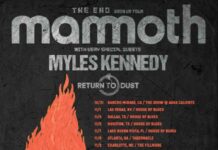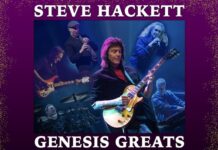Concert Review by Shawn Perry
Six months after seeing David Gilmour and Rick Wright play the former’s new solo album in its entirety along with a choice selection of Pink Floyd material, I ventured over to the Hollywood Bowl to witness a colossal production of The Dark Side Of The Moon featuring Roger Waters, Nick Mason, and a cast of 10 supporting musicians. I guess you could say I’ve now seen Pink Floyd in 2006 — one half in April and the other half in October. Even though the two halves came together for Live 8 on July 7, 2005, it seems more unlikely than ever they will reunite again. That is unless activities of the past year are an indication of bigger and better things over the horizon.
Waters, of course, is well known for doing things on a massive scale. After leaving Pink Floyd, he continued his conceptual odyssey, staging high-tech shows around his two solo albums from the 80s, The Pros And Cons Of Hitch Hiking and Radio KAOS. When Gilmour, Mason, and Wright moved forward by taking the Pink Floyd name, Waters wanted to make sure everyone knew who was responsible for the words and much of the music. Even when he was still with Pink Floyd, he made sure he got a by-line for The Wall, which he had claimed was largely his from the get-go. So it was no surprise when the ever ambitious Waters restaged The Wall at the site of Potsdamer Platz, formerly “no-man’s land” next to the fallen Berlin Wall. The concert was bigger than anything Waters had ever done with Pink Floyd. It featured a 550-foot long, 82-foot high wall, a slew of wacky guest stars, and a crowd that grew to some 500,000. Waters picked up the tab, made back his money from the CD and video sales of the event, and donated the profits to the World War Memorial Fund for Disaster Relief. At this point, he’d pretty much washed his hands of Pink Floyd.
In 1992, Waters released Amused To Death, arguably his finest post-Floyd album. Without a tour to support it, the record didn’t get the attention it deserved and was largely ignored. In 1999, he finally hit the road, paying proper homage to the record as well as revisitng a batch of oldies, many that hadn’t seen the light of day in over 20 years, not even by the current incarnation of Pink Floyd. Still, with no new album, it was questionable as to whether he was still the creative architect he’d always alleged to be.
Certainly, there were random new songs filtering out, like the insignificant “Each Small Candle,” but Waters’ main focus seem to revolve around Ça Ira, an opera based on the French Revolution he worked on for years. In the midst of its 2005 release, Waters rejoined the members of Pink Floyd for a historical one-time performance at Live 8. Afterwards, he was hot to reunite the group for other projects. But Gilmour was steadfast in his disinterest to doing any such thing, releasing his own solo album and touring small venues to great acclaim. It was as if Waters had no other choice but to grab the reins and revert back to the other big Pink Floyd album: The Dark Side Of The Moon. He received a request to perform the album at Magny Cours, site of the Formula 1 Grand Prix race in France, and a light bulb went off. A full tour was put together with The Dark Side Of The Moon as its centerpiece. Then Floyd drummer Nick Mason signed on to play select dates in Europe and the States, and the novel of idea of seeing the four members of Pink Floyd play Pink Floyd music in the year of 2006 became a reality.
The Creative Genius Of Pink Floyd
The three-day stand at the Hollywood Bowl served as the pinnacle of the tour. These were the last dates for Mason, who may have headed home and tried to figure out how he could bring the headstrong leaders of one of the greatest rock bands in history back to the tables for another round. Or he may have gone into the garage and polished the chrome on one of his many exotic sports cars. Either way, he certainly couldn’t have encountered the hassle of getting in and out of the Hollywood Bowl the way most common folk did.
For all its prestige and historical significance, the Hollywood Bowl is painfully inaccessible. If you want to park anywhere near it, you need to get there a couple of hours early and be prepared to pay as much as $40. I decided to park for free a mile away, behind the El Capitan Theatre where Jimmy Kimmel does his late-night show. With little time to spare, I grabbed a burger and a couple of beers at the Hooters directly across the street from the famous Grauman’s Chinese Theatre. Citing the gridlock at Highland and Hollywood Blvd., I opted to walk up the hill to the Bowl instead of taking the three dollar shuttle ride. It was good to walk the food and drink off, and I was able to apply my savings toward a nifty ten dollar black concert tee that obliquely proclaimed “Roger Waters — The Creative Genius Of Pink Floyd.” Even at this stage in his career, the man’s ego is something to behold.
I was on the grounds just after seven and firmly in my seat by 7:30, the designated time for blast off. Who knows, maybe Waters and his entourage got caught in the traffic snarl too, because it was another half-hour before the show started. In the meantime, the crowd was mildly entertained by a video image of a smoldering cigarette, a cocktail, and a hand turning the dial of an old radio. Waters wandered on the stage without so much as a “hello,” and the band went right into an explosive — literally and figuratively — “In The Flesh,” a reliable opener that never loses its luster. Aside from the main attraction, The Wall got plenty of pampering as “Mother,” with Katie Kissoon beautifully recreating Gilmour’s vocal parts, came along, enrapturing the stupefied audience in its grip.
But before The Wall came down, Waters took a step back to the medieval 60s with his anamorphic paean to psychedelia, “Set The Controls For The Heart Of The Sun.” This would serve as Waters’ tribute to Syd Barrett, the deceased leader of the original Pink Floyd. During his tour, Gilmour did one better by actually playing a Barrett song. Nevertheless, the video montage of the Madcap went well with the spacey arrangement and breezy sax work of Ian Ritchie, serving as a formidable education for anyone without a clue to the origins and mindset of the Floyd. “Shine On You Crazy Diamond” and “Have A Cigar” aptly covered the Wish You Were Here period, while the title track itself received a rudimentary reading, lacking the smoothness of Gilmour’s relaxed and mild tenor. Why Waters insists on singing this song is beyond reproach. He wrote the bloody words, and is therefore entitled to recite them in any manner he chooses.
One Pink Floyd album that was undeniably under the helm of Roger Waters is The Final Cut. Some call it brilliant, others call it a cheap sequel to The Wall, and still others including Gilmour himself consider it a Roger Waters solo album. “Not Now John,” its strongest track, featured the Pink Floyd guitarist singing and playing one his signature solos. Perhaps for this reason alone, Waters avoided it completely and rolled out a couple of other woozy tunes from the disc instead, “Southampton Dock” and “The Fletcher Memorial Home,” accompanied by lofty, yet timely video clips. The sequential drama prepared everyone for the majesty of “Perfect Sense,” the lone star from Amused To Death. Addressing the mass media madness of the first Gulf War, the song features former Ikette/soul songstress PP Arnold uttering such lines as “And the Germans killed the Jews/And the Jews killed the Arabs/And the Arabs killed the hostages/And that is the news/And is it any wonder/That the monkey’s confused…” No matter how you look at it, Waters’ lyrics always seem to cut straight to the bone.
The fiesty concertgoers were practically lulled to sleep when “Leaving Beirut,” a new autobiographical tome with a more marauding narrative than anything Dylan ever wrote, was introduced. Its uncharacteristic flavor sent loads of folks to the beer bar, but the mometum was rapidly recovered by “Sheep.” Snowy White, one of three guitarists in the band and backup to Gilmour on the original Animals tour with Pink Floyd, flawlessly recreated the solos as an inflated pink pig branded with messages like “Impeach Bush” on its ass floated over the bedazzled audience, who ate it up like honey-baked ham on a spittle.

There was a short intermission before the main event. I managed to miss the introduction of Nick Mason as I pushed my way through a throng of ambling drunks, trying to catch the opening stanzas of “Speak To Me.” Although Waters wrote all the lyrics, The Dark Side Of The Moon needs the synergy of Gilmour’s guitar work and vocals, as well as Wright, whose keyboards and written contributions to the album have never received the credit they deserve. Still, Mason’s drumming on “Time” was a wonderful thing to hear and see. “Money,” despite a slight lyrical hiccup from guitarist Dave Kilminster, was largely driven home by the rhythm machine of Waters and Mason. But the climax of the piece didn’t arrive until “Brain Damage/Eclipse,” which Waters has a major stake in. Joining the multitudes and singing at the top of my lungs — “All that is now/All that is gone/ All that’s to come/ And everything under the sun is in tune/But the sun is eclipsed by the moon..” — sent a shiver up and down my spine that resonated for two days.
After numerous bows, waves, and hugs, it was back to The Wall for “The Happiest Days Of Our Lives,” “Another Brick In The Wall,” “Vera,” “Bring The Boys Back Home,” and the inevitable closer, “Comfortably Numb.” While the first four are clearly within Waters’ invariable range, “Comfortably Numb,” Pink Floyd’s own “Stairway To Heaven,” always goes down better with Gilmour in the pilot’s seat. But all that didn’t seem to matter as thousands (me included) enthusiastically joined in on the choruses and the sky lit up with a barrage of pyrotechnics. The finale almost outdid the Rolling Stones, who had checked in at the Bowl the year before.
I was exhausted, a bit inebriated, and in no mood for the walk back to my car. But after a $12 Long Island Ice Tea at the swanky Renaissance Hollywood Hotel bar, it was like I was floating on a magic carpet over the Arabian desert. I gave some serious thought about returning for the third and final night, but realized that wasn’t going to happen. Then I looked into the sky and noticed a radiant full moon glowing through the converging cloud cover, wondering what the dark side was really like. It’s amazing what the right music and a little alcohol will conjure up.




















